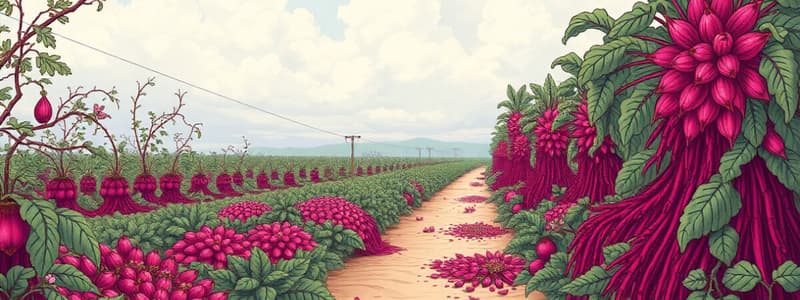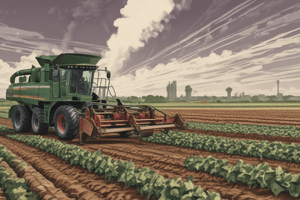Podcast
Questions and Answers
What is the duration of the harvesting campaign for sugar beet?
What is the duration of the harvesting campaign for sugar beet?
- From the end of September to mid-January (correct)
- From November to February
- All year round
- From mid-January to end of September
What is done to determine the sugar percentage of a sugar beet load?
What is done to determine the sugar percentage of a sugar beet load?
- Weighing the entire truckload
- Calculating based on the delivery time
- Visual inspection by factory staff
- A sample is taken for testing (correct)
What constitutes tare in the context of sugar beet harvesting?
What constitutes tare in the context of sugar beet harvesting?
- The weight of the clean beet delivered
- Only the soil from the harvested beets
- The estimated sugar content in the beet
- Anything other than beet in the load, such as stones and leaves (correct)
Why is nitrogen content checked in the sugar beet samples?
Why is nitrogen content checked in the sugar beet samples?
What happens to the sugar beet after it is weighed and sampled?
What happens to the sugar beet after it is weighed and sampled?
What method of unloading uses a powerful jet of water?
What method of unloading uses a powerful jet of water?
What is the purpose of checking the soil tare in sugar beet processing?
What is the purpose of checking the soil tare in sugar beet processing?
Which of the following accurately describes the process of dry unloading?
Which of the following accurately describes the process of dry unloading?
What is the purpose of adding lime to the sugar juice during processing?
What is the purpose of adding lime to the sugar juice during processing?
What happens to the muddy juice extracted from the clarifiers?
What happens to the muddy juice extracted from the clarifiers?
How is the clear juice from the clarifiers concentrated?
How is the clear juice from the clarifiers concentrated?
What indicates that the sugar crystals have reached the required size during crystallization?
What indicates that the sugar crystals have reached the required size during crystallization?
What is the name of the mixture of syrup and sugar crystals before separation?
What is the name of the mixture of syrup and sugar crystals before separation?
What occurs to the syrup after it has been separated from the sugar crystals?
What occurs to the syrup after it has been separated from the sugar crystals?
What is molasses in the sugar processing context?
What is molasses in the sugar processing context?
How is raw sugar dried after processing?
How is raw sugar dried after processing?
What is bagasse used for in the sugar processing industry?
What is bagasse used for in the sugar processing industry?
What is the initial extraction step for sugar juice from sugarcane?
What is the initial extraction step for sugar juice from sugarcane?
What is the purpose of washing beet before processing?
What is the purpose of washing beet before processing?
What is the main component extracted from beet during the diffusion process?
What is the main component extracted from beet during the diffusion process?
How does the counter-flow principle operate in the extraction process?
How does the counter-flow principle operate in the extraction process?
What happens to the exhausted beet slices after sugar extraction?
What happens to the exhausted beet slices after sugar extraction?
What is the moisture content of the pressed pulp after extraction?
What is the moisture content of the pressed pulp after extraction?
What is the primary byproduct of the sugar processing operation?
What is the primary byproduct of the sugar processing operation?
What substances are primarily responsible for juice purification?
What substances are primarily responsible for juice purification?
What does carbonatation primarily aim to achieve in the crystallization process?
What does carbonatation primarily aim to achieve in the crystallization process?
What is the final color of the juice after successful juice purification?
What is the final color of the juice after successful juice purification?
What can happen to sucrose during the diffusion process?
What can happen to sucrose during the diffusion process?
What percentage of sugar does the raw juice contain after extraction?
What percentage of sugar does the raw juice contain after extraction?
What is absorbed by chalk particles during carbonatation?
What is absorbed by chalk particles during carbonatation?
What is one potential problem when operating diffusion under alkaline conditions?
What is one potential problem when operating diffusion under alkaline conditions?
Which step is crucial for reducing color formation in sugar production?
Which step is crucial for reducing color formation in sugar production?
What is the primary purpose of evaporators in the sugar production process?
What is the primary purpose of evaporators in the sugar production process?
What is referred to as mother liquor in the crystallization process?
What is referred to as mother liquor in the crystallization process?
Which component is primarily produced during the separation of syrup from sugar crystals in centrifugals?
Which component is primarily produced during the separation of syrup from sugar crystals in centrifugals?
What is the role of vacuum pans in the sugar production process?
What is the role of vacuum pans in the sugar production process?
What happens to the syrup obtained from the first batch of raw sugar?
What happens to the syrup obtained from the first batch of raw sugar?
What is the main use of molasses after the sugar extraction process?
What is the main use of molasses after the sugar extraction process?
How is the sugar juice purified after being extracted from sugarcane?
How is the sugar juice purified after being extracted from sugarcane?
What is the final outcome of the process from beet washing to white sugar production?
What is the final outcome of the process from beet washing to white sugar production?
Which aspect of sugar processing involves the growth of sugar crystals?
Which aspect of sugar processing involves the growth of sugar crystals?
What is done with the bagasse after the sugar juice is extracted?
What is done with the bagasse after the sugar juice is extracted?
What is a characteristic of AP sugar as produced in the sugar refining process?
What is a characteristic of AP sugar as produced in the sugar refining process?
What are centrifugals used for in sugar production facilities?
What are centrifugals used for in sugar production facilities?
Which transport method is primarily used for sugarcane in Australia?
Which transport method is primarily used for sugarcane in Australia?
What does the term 'massecuite' refer to in the sugar production process?
What does the term 'massecuite' refer to in the sugar production process?
Flashcards
Sugar Beet Campaign
Sugar Beet Campaign
The period when sugar beets are harvested and processed into sugar. It typically starts in late September and continues until mid-January.
Sugar Beet Harvesting
Sugar Beet Harvesting
The process of removing sugar beets from the ground, cleaning them, and cutting off the tops. This is done mechanically, using specialized equipment.
Sugar Beet Tops
Sugar Beet Tops
The leaves of the sugar beet plant, which are a valuable source of animal feed, comparable in value to turnips.
Weighbridge
Weighbridge
Signup and view all the flashcards
Sampling Sugar Beets
Sampling Sugar Beets
Signup and view all the flashcards
Tare
Tare
Signup and view all the flashcards
Sugar Content (Pol)
Sugar Content (Pol)
Signup and view all the flashcards
Reception Area
Reception Area
Signup and view all the flashcards
Diffusion
Diffusion
Signup and view all the flashcards
Cossettes
Cossettes
Signup and view all the flashcards
Raw Juice
Raw Juice
Signup and view all the flashcards
Pulp
Pulp
Signup and view all the flashcards
Carbonatation
Carbonatation
Signup and view all the flashcards
Milk of Lime
Milk of Lime
Signup and view all the flashcards
Thin Juice
Thin Juice
Signup and view all the flashcards
Evaporation
Evaporation
Signup and view all the flashcards
Non-Sugars
Non-Sugars
Signup and view all the flashcards
Juice Purification
Juice Purification
Signup and view all the flashcards
Limestone
Limestone
Signup and view all the flashcards
Lime
Lime
Signup and view all the flashcards
Carbon Dioxide
Carbon Dioxide
Signup and view all the flashcards
Precipitate
Precipitate
Signup and view all the flashcards
Sugar
Sugar
Signup and view all the flashcards
Evaporators
Evaporators
Signup and view all the flashcards
Crystallization
Crystallization
Signup and view all the flashcards
Mother liquor
Mother liquor
Signup and view all the flashcards
Massecuite
Massecuite
Signup and view all the flashcards
Centrifuges
Centrifuges
Signup and view all the flashcards
Raw sugar
Raw sugar
Signup and view all the flashcards
AP sugar
AP sugar
Signup and view all the flashcards
Molasses
Molasses
Signup and view all the flashcards
Vacuum pans
Vacuum pans
Signup and view all the flashcards
Crystallizers
Crystallizers
Signup and view all the flashcards
Bagasse
Bagasse
Signup and view all the flashcards
Cane Railway
Cane Railway
Signup and view all the flashcards
What is bagasse?
What is bagasse?
Signup and view all the flashcards
What is clarification?
What is clarification?
Signup and view all the flashcards
What are clarifiers?
What are clarifiers?
Signup and view all the flashcards
What is filter mud?
What is filter mud?
Signup and view all the flashcards
What are evaporators or 'effets'?
What are evaporators or 'effets'?
Signup and view all the flashcards
What is syrup?
What is syrup?
Signup and view all the flashcards
What is crystallization?
What is crystallization?
Signup and view all the flashcards
What is massecuite?
What is massecuite?
Signup and view all the flashcards
What are centrifugals?
What are centrifugals?
Signup and view all the flashcards
What is molasses?
What is molasses?
Signup and view all the flashcards
Study Notes
Sugar Beet Production
- Harvesting: Campaign runs from late September to mid-January, continuous 24/7. Harvested mechanically, removing roots, cleaning, and topping. Leaves are valuable animal feed.
- Transport: Harvested beets are transported by lorry to processing plants.
- Weighing and Sampling: Lorries are weighed and sampled for sugar content and tare (e.g., soil, stones, beet tops), determining net weight. Farmers are paid per ton of clean beet based on a sliding scale related to sugar content.
Sugar Beet Processing
-
Reception: Beet loads are weighed and sampled before being tipped onto concrete pads to form heaps. Samples are checked for soil/crown tare and sugar/nitrogen content for future fertilizer recommendations. Beet is moved into a channel and washed towards the plant.
-
Unloading: Two unloading methods:
- Dry: Beet is conveyed to open-air silos for storage.
- Wet: Beet is washed from the lorry by a powerful water jet. Stones/grass are removed en route to processing. Thorough washing removes clay/sand.
-
Diffusion:
- Beet is sliced (cossettes).
- Sugar is extracted by diffusion with hot water (around 70°C) in a diffuser (counterflow principle).
- Raw juice (14% sugar, black/dark red) is produced.
- Exhausted beet slices (pulp) are mixed with molasses, dried, and used as animal feed.
-
Extraction Tower: Beet is washed, sliced, and processed in a diffuser to extract sugar into a water solution (raw juice).
Purification and Concentration
-
Saturation (Juice Purification): Impurities (non-sugars) are removed using lime and carbon dioxide (from limestone). Solid material is filtered off. Juice is light yellow.
-
Carbonatation: Raw juice is treated with hot lime milk to precipitate impurities (e.g., sulfate, phosphate, proteins). Carbon dioxide is added to precipitate lime as calcium carbonate. This clarifies the liquid as thin juice (light brown). pH adjustments (soda ash) and sulphitation may occur during processing to reduce color formation.
-
Evaporation: Thin juice (14% sugar, 1% non-sugars) is concentrated in evaporators, from 14% to 60% sugar.
Crystallization and Refinement
-
Evaporation and Crystallization: Thin juice is concentrated to thick juice (60% sugar) for storage. Recycled sugar is added to thick juice which becomes mother liquor. Mother liquor is further concentrated under vacuum. Fine sugar crystals are added to seed growth. Massecuite (mixture of sugar crystals and syrup) is formed.
-
Centrifugals: Sugar is separated from syrup by centrifugals. Wet sugar is dried, screened, cooled, and stored in large silos. Remaining syrup continues through boiling stages to extract more sugar. Final syrup (molasses) high in impurities and used for animal feed.
-
Sugar Yield: 100 tonnes of beets yield approximately 12-14 tonnes of sugar and 3-4 tonnes of molasses.
Cane Sugar Production
-
Harvesting and Transport: Cane is harvested and transported to the mill. Weight recorded at automated cane receiving stations.
-
Transportation methods in Australia:
- Primarily via railway network (over 4000km of narrow-gauge track and 95% of cane transport).
- Some use road transport.
-
Crushing and Extraction: Cane is crushed, milled and shredded. Sugar juice is separated from fibrous material (bagasse). Pulp and juice is collected.
-
Purification: Impurities are removed by adding lime and heating the limed juice. This settles out impurities in clarifiers.
-
Concentration: Clear juice is boiled in a vacuum in a series of vessels (effet/evaporators) to create syrup.
-
Crystallization: Syrup, with seeded crystals, is boiled in vacuum pans to grow and concentrate larger sugar crystals forming Massecuite.
-
Separation by Centrifugals: Sugar is separated from remaining syrup (molasses) by centrifugals. Syrup from the centrifugals can be used again for further sugar extraction. Molasses is leftover.
-
Final Stages/Storage: Raw sugar is dried with air, stored briefly in bins at the mills. Raw sugar crystals are collected to be dried, stored in bulk silos.
Studying That Suits You
Use AI to generate personalized quizzes and flashcards to suit your learning preferences.




